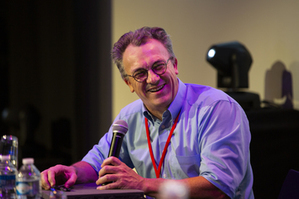Man to Mars with an artificial ecosystem
4 October 2019
C. Lasseur European Space Agency & Partenaires MELiSSA
Human missions beyond Earth orbit requires high masses of human metabolic consumables (e.g. oxygen, water, food). These masses are today not compatible with the performance of the existing launchers. Due to Earth, Mars, Sun positions as well as accuracy of landing and safety, it is not possible to consider regular re-supply. Therefore, only two alternatives exist:
- bigger launcher and/or
- full recycling on board.
If oxygen and water are rather simple molecules, which can be produced with conventional engineering approach from grey water and CO2, the real difficulties start from food production and recycling of human metabolic wastes. Both being by definition complex, diverse and issued biological processes.
Seeded in 1987 by AIRBUS (i.e. MATRA), with a precursor flight experiment on board the Chinese rocket longue Marche, conceptualized and published in October 1988, and initiated in March 1989, the European project of regenerative life support ( i.e. MELiSSA: Micro Ecological Life Support System altenative), from its early days has followed a very progressive approach. It is correct to state the key challenges of MELiSSA are: how to select, to assemble and to demonstrate processes and technologies to reach the highest degree of closure within the ALISSE criteria set: Mass, Energy, Efficiency, Safety, Reliability and Crew Time.
Mainly due to these final objectives, the overall project follows a system engineering approach.
Within Phase 1, Basic R&D, the processes and technologies, generally at low TRL are characterized a stoichiometry’s level, energy and safety, then static and dynamics models are elaborated for an integration in the overall system.
Within phase 2 called: Preliminary Flight experiments, After this intensive phase 1 characterization, the critical space issues are identified (e.g. reduced gravity, multi-phases processes, radiations,.. ), proposed for flight experiment, generally in LEO.
Within phase 3: due to the extremely high safety conditions, one understand the need of ground demonstrator with a real human waste and a living crew. Issued of phase 1 and 2, the selected processes and technologies (e.g. bioreactors, greenhouses, filtration,..) are progressively integrated and demonstrated over a long period of time. The core of this activity is performed at the MELiSSA Pilot plant located in Spain.
In parallel, of these 3 phases run as well the Phase 4: Technology transfer, where already 4 spin-off companies have been created. Initiated to transfer space technology to Earth, this phase is becoming more and more a platform of collaboration for join R&D efforts.
Phase 5, which has taken a reasonable amplitude over the last years: Education and Communication is led by the MELiSSA foundation and support PhDs Students and STEM activity (e.g. AstroPlants).
Today, after more than 30 years of activities, the project gathers a very large community from scientists to engineers, from universities to spin-off companies, from industry to space companies, from students to European civil servants. This large community distributed over 15 European countries is pursuing two main objectives: - Space life support system and
- Terrestrial circular economy.